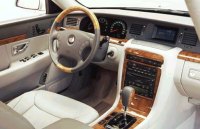|
 In
the past, we thought Kia was only capable of making small and cheap
cars
(the mid-size Optima is not counted because it is actually a rebadged
Hyundai
Sonator). Surprisingly, without establishing a solid image, Kia decided
to launch a luxury executive car called Opirus in Korea and Amanti
overseas.
The car is based on Hyundai Equus - the luxurious car used by wealthy
businessmen
and top government officials in Korea. The Opirus measures 5 meters in
length and weighs 1822kg. Is it a wise act? In
the past, we thought Kia was only capable of making small and cheap
cars
(the mid-size Optima is not counted because it is actually a rebadged
Hyundai
Sonator). Surprisingly, without establishing a solid image, Kia decided
to launch a luxury executive car called Opirus in Korea and Amanti
overseas.
The car is based on Hyundai Equus - the luxurious car used by wealthy
businessmen
and top government officials in Korea. The Opirus measures 5 meters in
length and weighs 1822kg. Is it a wise act?
Although
the
Opirus looks
more modern than the rectangular Equus, it is still a conservative
design.
The body profile is 2-dimensional rather than 3D, like a brick with its
front end, rear end and top smoothened a bit. In my opinion it looks
like
an early-90s Buick or Cadillac. The big chromed grille tries too hard
to
make itself look prestige. The quad circular headlamps is a carbon copy
of the last generation Mercedes E-class. This car does not have its own
character.
The proportion
of
its chassis
is outdated. Measuring almost 5 meters, it should be able to
accommodate
a long wheelbase. However, the Opirus actually rides on 2800mm
wheelbase,
some 50mm shorter than a Mercedes E-class, let alone the similarly-long
S-class. No wonder you can see the Opirus has old-fashion long
overhangs
at both front and rear. Kia has its own explanation: the Opirus is
priced
so low that it actually competes with cars a class or two smaller. In
Korea,
it is an alternative to Hyundai XG rather than Equus. In the United
States,
it rivals with Toyota Avalon (the forgotten 6-seat Camry), Volkswagen
Passat
or the like. Then people will appreciate its "big-car look" for it is
more
graceful.
This
is not a new
idea. General
Motors has been doing business like this for decades. Today, Buick
LeSabre
and Park Avenue still follow this philosophy. Especially is LeSabre,
which
is still a solid player in the field. If Amanti want to be successful,
the LeSabre is the one it should beat.
Like
the Buick -
perhaps
more so - the dinosaur size of Opirus handicaps its handling seriously.
It works best on straight line, hate most tight corners. The soft
suspensions
lead to a lot of roll, understeer and floaty ride on undulation. The
light
and uncommunicative speed-sensitive steering never inspires its
driver.
Performance
is
also hampered
by the 1822kg kerb weight. Unlike its platform-donor car, the Opirus is
offered with only a V6 but not V8. This is an outdated Mitsubishi
design,
3.5 litres, 24 valves, without any tricky intake system or variable
valve
timing. It still employs iron block, but this doesn't matter to the
1822kg
Opirus. What hurts is the lack of power - it pumps out just 195hp and
220
lbft, even weaker than a typical 3.0-litre V6. Even though it is helped
by a 5-speed automatic, it takes nearly 9 seconds to accelerate from 0
to 60mph. In short, performance is sluggish.
 It
is better stay calm and enjoy its near-luxury cabin. This is a roomy
place
- not as roomy as Ssangyong Chairman though - a true 5-seater. Leg and
head room at the back is generous. The interior design and ambience is
very much like Japanese executive sedans, Toyota Crown and Nissan
Gloria
in particular. Plastic and leather used are pretty good quality. Switch
gears have quality feel. The instrument is EL backlit like some Lexus
(although
increasingly more Toyota now share this feature). What a pity it still
employs fake wood. Admittedly, only the highest class Korean cars like
Chairman and Equus can afford real wood. Anyway, the Kia is loaded with
so many standard equipment that admirers of Korean cars won't be
disappointed. It
is better stay calm and enjoy its near-luxury cabin. This is a roomy
place
- not as roomy as Ssangyong Chairman though - a true 5-seater. Leg and
head room at the back is generous. The interior design and ambience is
very much like Japanese executive sedans, Toyota Crown and Nissan
Gloria
in particular. Plastic and leather used are pretty good quality. Switch
gears have quality feel. The instrument is EL backlit like some Lexus
(although
increasingly more Toyota now share this feature). What a pity it still
employs fake wood. Admittedly, only the highest class Korean cars like
Chairman and Equus can afford real wood. Anyway, the Kia is loaded with
so many standard equipment that admirers of Korean cars won't be
disappointed.
The best way
to
enjoy the
Opirus is to drive it slowly on straight. Enjoy the smooth engine and
gearbox,
the soft ride, the comfy seats and the quality materials surrounding
you.
Slow down, slow down.... if you have retired and do not have a lot of
money
to spend, this could be the right car for you. Unfortunately, to most
of
us, cars are not "houses in wheels". Once we take dynamics into
account,
this Kia is immediately discarded from the list. |